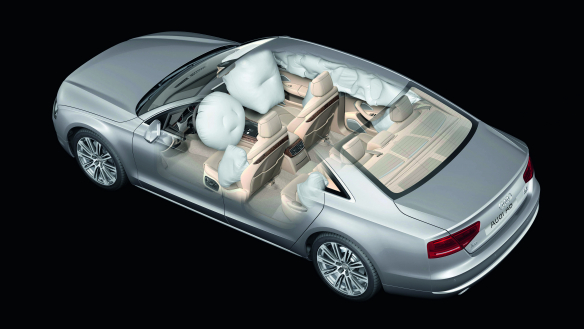Adaptive restraint system
Passengers in many models are protected by the Audi adaptive restraint system, which in some model series is networked with the predictive safety system Audi pre sense. The system draws its information from an entire array of acceleration and pressure sensors.
The adaptive restraint system intelligently manages the interplay between the airbags and the belt force limiters to protect passengers of different sizes more effectively than conventional systems. Sensors on the front seat rails detect how far forward or back the seat is positioned. Because the control unit then knows the approximate position of the passenger, it can ensure that better use is made of the distance over which the upper body is slowed by the belt and the airbag. Together with Audi pre sense, it reduces this distance by several centimeters because the belts are tensioned before the crash occurs.
If a passenger is sitting close to an airbag, a portion of the air is quickly expelled via valves after the airbag inflates so that the head and chest are gathered in more gently by the airbag. In other cases the valves remain closed longer. The variable belt force limiters are also designed to be adaptive. They control belt tension so that the load on the chest remains as low as possible. Bracing structures, energy-absorbing pads and crash-optimized pedals reduces loads on the feet and legs.
The structural design of the seats and headrests is an important element of safety design, especially in the case of a rear-end collision. These types of accidents frequently occur at traffic lights, usually with impact speeds between 15 and 50 km/h (9.32 and 31.07 mph). In these collisions, the seat back is accelerated to between 7 and 25 km/h (4.35 and 15.53 mph) within a tenth of a second. The integral head restraint system, which is standard in every Audi model, acts here to counter the risk of whiplash injuries.
All Audi models are equipped with either two or four side airbags to support the hips and chest of the occupants in the event of a side-impact collision. In open-topped models, in the R8 and in the TT, the side airbags also protect the head. In all other models, this function is provided by the head airbag system. It spans the area from the A- to the C-pillars and opens like a curtain from the roof frame to the door sill. Three-point automatic belts with belt tensioners and Isofix mountings for child seats round out the safety package.
Status: 2011
